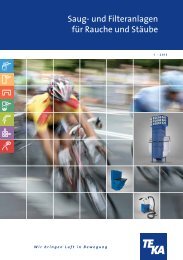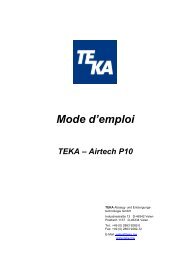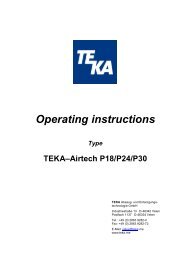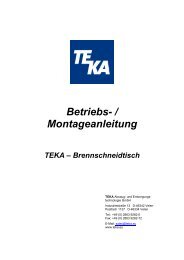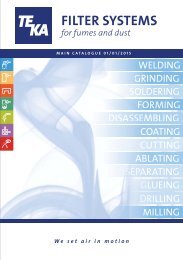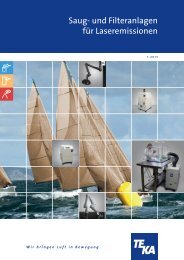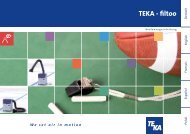Operating instructions - TEKA GmbH
Operating instructions - TEKA GmbH
Operating instructions - TEKA GmbH
Create successful ePaper yourself
Turn your PDF publications into a flip-book with our unique Google optimized e-Paper software.
<strong>Operating</strong> <strong>instructions</strong><br />
Type<br />
<strong>TEKA</strong> – dustoo<br />
<strong>TEKA</strong> Absaug- und Entsorgungstechnologie<br />
<strong>GmbH</strong><br />
Industriestraße 13 D-46342 Velen<br />
Postfach 1137 D-46334 Velen<br />
Tel.: +49 (0) 2863 9282-0<br />
Fax: +49 (0) 2863 9282-72<br />
E-Mail: sales@teka.eu<br />
www.teka.eu
Contents<br />
1 Drawing/description of the parts..................................................................................................... 3<br />
2 Preface ............................................................................................................................................... 4<br />
3 How <strong>TEKA</strong>-dustoo works ................................................................................................................. 5<br />
4 Safety <strong>instructions</strong>............................................................................................................................ 5<br />
5 Starting up ......................................................................................................................................... 7<br />
5.1 Connection of the extraction element ......................................................................................... 7<br />
5.2 Connecting the device .................................................................................................................. 7<br />
5.3 Connecting the automatic dedusting system (option).............................................................. 7<br />
6 Explanation of the control elements ............................................................................................... 8<br />
7 Maintenance ...................................................................................................................................... 9<br />
7.1 Manual cleaning of the filter cartridge ........................................................................................ 9<br />
7.2 Automatic dedusting of the filter cartridge (option)................................................................. 10<br />
7.3 Emptying the dust container ...................................................................................................... 11<br />
7.4 Changing the filter cartridge ...................................................................................................... 11<br />
7.5 Replacing the carbon brushes .................................................................................................. 12<br />
8 Disposal ........................................................................................................................................... 13<br />
9 Technical data ................................................................................................................................. 14<br />
10 List of spare parts ....................................................................................................................... 15<br />
11 Declaration of conformity <strong>TEKA</strong>dustoo ................................................................................... 16<br />
BA_dustoo_121122_GB.doc - 2 - 2012-11-22
1 Drawing/description of the parts<br />
Drawing No. 12473703<br />
Pos.1<br />
Pos.2<br />
Pos.3<br />
Pos.4<br />
Pos.5<br />
Pos.6<br />
Pos.7<br />
Pos.8<br />
Pos.9<br />
Pos. 10<br />
Filter alarm light: red<br />
<strong>Operating</strong> indicator lamp: green<br />
Potentiometer for speed regulation<br />
Main switch<br />
Handle<br />
Turbine housing<br />
Housing of the dedusting system<br />
Cartridge housing<br />
Filter cartridge<br />
Screw connection of the filter cartridge<br />
Pos.11<br />
Pos.12<br />
Pos.13<br />
Pos.14<br />
Pos.15<br />
Pos.16<br />
Pos.17<br />
Pos.18<br />
Pos.19<br />
Pos. 20<br />
Dust container<br />
Swivel castor with brake<br />
Swivel castor<br />
Snap fastener<br />
Snap fastener<br />
Mains plug<br />
Outlet grid<br />
Clock generator of the dedusting<br />
process (option)<br />
Extraction nozzle<br />
Cover plate<br />
BA_dustoo_121122_GB.doc - 3 - 2012-11-22
2 Preface<br />
Congratulations on the acquisition of the filter unit out of the series <strong>TEKA</strong> dustoo!<br />
Thanks to continued development, our engineers make sure that our filter systems correspond to<br />
the state of the art. Nevertheless, misuse or inappropriate behavior can endanger your safety.<br />
Therefore, observe the following <strong>instructions</strong> for a successful application of the filter unit:<br />
Read this manual before using the system and observe the safety <strong>instructions</strong> in order<br />
to avoid injuries!<br />
An improper use of the unit can lead to serious injuries or cause death!<br />
Keep this manual in a safe place! Consider the manual as one part of the product!<br />
Observe all indications marked on the product!<br />
Take the local conditions at the installation site into consideration!<br />
Observe the <strong>instructions</strong> of the manufacturer. If in doubt, contact the manufacturer:<br />
Phone: +49 28 63 - 92 82 - 0<br />
Fax: +49 28 63 - 92 82 – 72<br />
We thank you for your trust and wish you a successful application!<br />
BA_dustoo_121122_GB.doc - 4 - 2012-11-22
3 How <strong>TEKA</strong>-dustoo works<br />
The <strong>TEKA</strong>-dustoo filtering device is used predominantly for the precise extraction of dust and<br />
smoke. In order to carry this out the devices must have one or two flexible extraction hoses or a<br />
collection device that is suitable for the application.<br />
Limitations of use:<br />
Soldering smoke containing oils, aluminium dust, sanding dust, dust extraction, gases, water, etc.<br />
metals.<br />
(If in doubt please contact the manufacturer!)<br />
The air that contains the toxins is collected by the intake device and enters the filtering device<br />
through the extraction hose. This is where the toxins are separated in the form of particles on the<br />
surface of the integrated filter cartridge (Pos.9). The purified air is sucked up by the turbines and<br />
returns to the work area through the exit grille.<br />
Warning:<br />
As soon as the resistance of the filter cartridge has reached its maximum level because of the<br />
separated dust particles, the electronic control system activates the red Filter alarm light (pos.1).<br />
Manual cleaning should be carried out with the help of a pressurised air pistol, the pressurised air<br />
must be distributed homogeneously over the whole surface of the filter which then removes the<br />
layer of dust formed there. (see section 7.1: “Cleaning the filter cartridge”)<br />
The dust that has been removed is collected in the dust container where it can be disposed of. (see<br />
section 7.4: “Emptying the dust container”“)<br />
4 Safety <strong>instructions</strong><br />
When using electrical appliances you must abide by the following basic safety measures as<br />
protection against electric shocks and to avoid the risk of injuries or fires:<br />
• Read and abide by these indications before using the device<br />
• Keep these <strong>instructions</strong> of use and maintenance in a safe place<br />
• Only use the device for extracting dry dust and smoke<br />
• Do not use the device to extract explosive or inflammable gases<br />
• Do not employ the unit for setting it in explosive zones, e.g. zone 0, zone 1, zone 2, zone<br />
20, zone 21, zone 22!<br />
• Do not employ the unit for sucking off burning or glowing materials, e.g. cigarettes,<br />
matches, metallic types of dust and/or splinters, paper, cleaning cloths, etc.!<br />
• Do not employ the unit for sucking off burning and/or inflammatory materials, e.g. oils<br />
and/or oil mist, fats, parting agent (e.g. silicone spray), cleaning agent, etc.!<br />
• Do not use the device to extract aggressive elements<br />
• Do not use the device to extract incandescent or burning substances<br />
• Do not use the device to extract liquids of any kind<br />
• Do not use the device to extract organic substances without obtaining prior written consent from<br />
the manufacturer<br />
• Protect the connectors from heat, humidity, oil and sharp edges<br />
BA_dustoo_121122_GB.doc - 5 - 2012-11-22
• Respect the connection voltage allowed (look at the indications on the nameplate!)<br />
• Only use <strong>TEKA</strong> accessories and spare parts<br />
• Do not start the device without a filter cartridge<br />
• Before opening the device, disconnect it from the mains<br />
• The air outlet should never be covered or blocked<br />
• Always check that the device is in a safe place and that the guiding roller’s brakes are on<br />
• When you are about to clean or carry out maintenance on the device, change parts or modify<br />
the device for a different operation you must disconnect it from the mains<br />
• The filter cartridges cannot be reused!<br />
• Remove the filters in accordance with the legal norms<br />
• Periodically check if the mains lead has signs of damage<br />
• The device must not be used if the mains lead is not in perfect condition<br />
• Only use dry non-greasy pressurised air at a pressure of 3 bar (min.) and 4 bar (max.)<br />
• The collection parts that are connected must not provoke movements in the <strong>TEKA</strong>-dustoo<br />
filtering device (e.g. in the extraction hose)<br />
• Make the extraction arm move on its path making the most of the thermal movements of the<br />
soldering smoke if possible<br />
• The maximum distance allowed to reach the soldering point must not exceed 25 cm<br />
• Do not use the filtering device if one or various parts are found to be faulty, are missing or<br />
damaged. Under these circumstances you must contact the <strong>TEKA</strong> service department<br />
(telephone 0049-28 63 / 92 82 - 0)<br />
• When extracting carcinogenic soldering dust, like materials that contain nickel or chrome, for<br />
example, you must comply by the technical ventilation requirements of TRGS 560 “Air<br />
return when working with dangerous carcinogenic substances“<br />
• For further information concerning TRGS 560, please contact the German Institute for<br />
Occupational Safety and Health (BGIA) in 53754 Sankt Augustin.<br />
BA_dustoo_121122_GB.doc - 6 - 2012-11-22
5 Starting up<br />
The filtering device is supplied ready for connection.<br />
The collection parts and any other possible accessories must be assembled or installed in the<br />
device before starting it up.<br />
5.1 Connection of the extraction element<br />
• Push the flexible connection hose as far as possible into the extraction nozzle (Pos.19).<br />
If you use a second hose, proceed as follows:<br />
• Remove the cover from the connection nozzle (Pos.19).<br />
• Push the flexible connection hose as far as possible into the extraction nozzle (Pos.19).<br />
Warning:<br />
For the filtering device to operate correctly you must guarantee a hermetic connection.<br />
The <strong>TEKA</strong> dustoo filter device should not move because of the collection parts that are connected<br />
to it (e.g. extraction hose).<br />
5.2 Connecting the device<br />
• Connect the filtering device to the mains.<br />
(Check the indications on the nameplate!)<br />
Warning:<br />
Any work with the electrical installation should be carried out by specialised electricians.<br />
Check the indications on the nameplate!<br />
5.3 Connecting the automatic dedusting system (option)<br />
As an option, dustoo can be ordered fitted with an automatic dedusting system (pos. 7). If the housing<br />
for the dedusting system is not installed yet at delivery, proceed as follows to connect the housing to the<br />
filter unit:<br />
• Disconnect the filter unit from the mains supply.<br />
• Release the toggle clamps between the cartridge housing (pos. 8) and the turbine housing (pos.<br />
6) and remove the turbine housing.<br />
• Place the housing containing the dedusting system (pos. 7) onto the cartridge housing, the<br />
discharge drilling pointing to the bottom. (Doing this, check if the sealing on the cartridge<br />
housing is damaged.)<br />
BA_dustoo_121122_GB.doc - 7 - 2012-11-22
• Place the turbine housing onto the compressed air container. (Doing this, check if the sealing on<br />
the compressed air container is damaged.)<br />
• Fix the turbine housing to the compressed air container with the help of the longer closing hook.<br />
As soon as the dedusting housing has been mounted, it must be connected to the local compressed air<br />
supply.<br />
• Connect an approved compressed air hose to the quick release coupling of the dedusting<br />
housing. (The external compressed air supply must be at least 3 bar and 4 bar maximum.)<br />
• The compressed air must be dry and oil free.<br />
• Connect the filter unit and the dedusting system to the mains supply.<br />
Attention:<br />
Only electricians are authorized to perform tasks regarding electrical connections!<br />
Observe indications made on the nameplate! The compressed air supply must be dry and oil free!<br />
The compressed air container has to be emptied before performing any maintenance and repair<br />
task!<br />
Without compressed air supply, the filter cartridge pollutes very fast.<br />
6 Explanation of the control elements<br />
Pos.1<br />
Red filter alarm light: Indicates a due filter check and change if necessary.<br />
Pos. 2<br />
Pos.3<br />
Pos.4<br />
Green operating indicator lamp: indicates that the device is in operation.<br />
The potentiometer regulates the number of revolutions of the turbine, i.e. it regulates the<br />
volumetric flow.<br />
Main switch: Switches the filter unit on or off.<br />
BA_dustoo_121122_GB.doc - 8 - 2012-11-22
7 Maintenance<br />
When filtering dust particles the degree of saturation of the filter cartridge is increased and the<br />
extraction power is reduced.<br />
The degree of saturation of the filter cartridge (Pos.9) is controlled electronically. In order to achieve<br />
an acceptable extraction performance from the device the filter cartridge must be dedusted as soon<br />
as the red filter alarm light lights up (Pos.1). (See section 7.1: “Cleaning the filter cartridge“)<br />
To loosen the dust particles you have to blow on the clean-air-side from the inside towards the<br />
exterior. The layer of dust that is loosened then falls in the dust container (Pos.11) made for this<br />
purpose. (See section 7.3: “Emptying the dust container“)<br />
The time the filter cartridge lasts greatly depends on its conditions of use therefore it cannot be set<br />
beforehand.<br />
If after cleaning the filter cartridge the filtering device does not reach the necessary working<br />
pressure the filter cartridge must be changed. (See section 7.4:”Changing the filter cartridge“)<br />
The filter unit <strong>TEKA</strong> dustoo is equipped with an alternating current turbine.<br />
After expiration of a certain amount of operating hours or as soon as the turbine does not run any<br />
more, the carbon brushes of the AC turbine have to be replaced.<br />
Warning:<br />
Whilst changing the filter cartridge the filtering device must be stopped. The changing of the filter<br />
cartridge and its disposal must only be carried out in a well-ventilated area with the use of an<br />
appropriate protective mask!<br />
We recommend: Protective half-mask DIN EN 141/143 protection level P3.<br />
Only someone with appropriate training should change the filter cartridge!<br />
7.1 Manual cleaning of the filter cartridge<br />
As soon as the red filter alarm light (Pos.1) lights up, the filter cartridge must be dedusted as<br />
follows:<br />
• Disconnect the device from the mains.<br />
• Remove the turbine housing (Pos.6) by opening the snap fasteners (Pos.14).<br />
• Clean the filter cartridge (Pos. 9) evenly with the help of a compressed air gun (The<br />
compressed air gun is available as an option.) from the inside to the outside for 5-10<br />
minutes (Pos.5).<br />
Place the turbine housing (Pos.6) onto the cartridge housing (Pos.8) and fix it with the snap<br />
fasteners (Pos.14).(Check if the sealing underneath the turbine housing (Pos.6) is<br />
damaged.)<br />
• Connect the filtering device to the mains supply.<br />
(Observe the indications on the nameplate!)<br />
Warning:<br />
While changing the filter cartridge or while dedusting, the filter unit must be stopped.<br />
Without compressed air supply, the cartridge filter pollutes very fast.<br />
BA_dustoo_121122_GB.doc - 9 - 2012-11-22
If the filter is manually beaten or washed manually, the filter material will be destroyed. The<br />
pollutants reach the ambient air!<br />
7.2 Automatic dedusting of the filter cartridge (option)<br />
If the dustoo is equipped with an automatic dedusting system, section 7.1 does not apply.<br />
The automatic dedusting system cleans the filter cartridge cyclically.<br />
Therefore, the dedusting system has to be connected to the device as described in section 5.4.<br />
The dedusting interval can be adjusted via the clock generator (Pos. 18) according to the produced<br />
amount of dust.<br />
The opening time is set to 1.25 seconds and the timer is set to 45 minutes.<br />
If these settings do not correspond to your use of the filter unit, you can change the settings as<br />
follows.<br />
Attention:<br />
The optional compressed air container must be emptied before performing any maintenance and<br />
repair task.<br />
Ventilöffnungszeit<br />
Test manuelle Abreinigung<br />
Taktzeiteinstellung<br />
Anschlusskabel<br />
opening time of the valve<br />
test manual dedusting<br />
setting of the cycle time<br />
connection cable<br />
BA_dustoo_121122_GB.doc - 10 - 2012-11-22
7.3 Emptying the dust container<br />
After a certain amount of time in operation the dust container (Pos.11) must be cleaned. When this<br />
process is necessary depends on the quantity of dust generated<br />
• Disconnect the device from the mains.<br />
• Remove the turbine housing (Pos.6) and the cartridge housing (Pos.8) by opening the snap<br />
fastener (Pos.15).<br />
• Empty the dust accumulated into a suitable recipient following the applicable norms and<br />
dispose of it appropriately.<br />
• Place the turbine housing (Pos.6) and the cartridge housing (Pos.8) on the dust container<br />
(Pos.11) and fasten them with the snap fastener (Pos.15).<br />
(Check if the sealing underneath the cartridge housing (Pos.8) is damaged.)<br />
• Connect the filtering device to the mains.<br />
(Observe the indications on the nameplate!)<br />
Warning:<br />
The emptying of the dust container must only be carried out in a well-ventilated area with the use of<br />
an appropriate protective mask!<br />
We recommend: Protective half-mask DIN EN 141/143 protection level P3.<br />
The above-mentioned tasks should only be carried out by personnel who have been specifically<br />
trained.<br />
Dispose of the dust according to legal regulations!<br />
7.4 Changing the filter cartridge<br />
• Disconnect the device from the mains supply<br />
• Remove the turbine housing (Pos.6) and a possible automatic dedusting system from the<br />
cartridge housing (Pos.8) by opening the snap fasteners (Pos.14).<br />
• Release the snap fasteners (Pos. 15) and remove the dust container.<br />
• Release the fixing screws (Pos10) on the upper side of the cartridge housing.<br />
• Withdraw the filter cartridge (Pos.9).<br />
• Insert the new filter cartridge into the cartridge guide.<br />
Warning:<br />
Only use <strong>TEKA</strong> spare parts!<br />
BA_dustoo_121122_GB.doc - 11 - 2012-11-22
• Tighten the fixing screws (Pos.10).<br />
• Place the turbine housing (Pos.6) and the cartridge housing (Pos.8) onto the dust container<br />
(Pos.11) and fix them with the help of the snap fasteners (Pos.14) and (Pos. 15).<br />
(Check if the sealing underneath the cartridge housing (Pos.8) is damaged.)<br />
• Connect the filter unit to the mains supply.<br />
(Observe the indications on the nameplate!)<br />
Warning:<br />
The changing of the filter and its disposal must only be carried out in a well-ventilated area with the<br />
use of an a Handycart AC ropriate protective mask!<br />
We recommend: Protective half-mask DIN EN 141/143 protection level P3.<br />
The above-mentioned tasks should only be carried out by personnel who have been specifically<br />
trained.<br />
Dispose of the dust according to legal regulations!<br />
7.5 Replacing the carbon brushes<br />
It is necessary to replace the carbon brushes of the AC turbine approx. every 300 operating hours.<br />
Proceed as follows:<br />
• Disconnect the filter unit from the mains supply.<br />
• Release the connecting screws at the cover plate (Pos. 20) and the turbine housing<br />
(Pos. 6).<br />
• Remove the cover plate (Pos. 20) from the turbine housing (Pos. 6).<br />
• Pull the blade receptacle of the mains line out of the blade terminal of the carbon brush.<br />
• Press the barb of the carbon brush down and withdraw the carbon brush.<br />
• Insert the new carbon brush until the barb locks into place.<br />
• Put the blade receptacle of the mains supply on the blade terminal of the new carbon<br />
brush.<br />
• Put the cover plate (Pos. 20) onto the turbine housing (Pos. 6). (Doing this, check if the<br />
sealing on the turbine housing (Pos. 3) is damaged.)<br />
• Fix the cover plate (Pos. 6) with the help of the connecting screws.<br />
• Connect the filter unit to the mains supply. (Observe the indications on the nameplate!)<br />
Attention:<br />
Only electricians are authorized to perform tasks regarding electrical connections.<br />
Observe the indications on the nameplate!<br />
BA_dustoo_121122_GB.doc - 12 - 2012-11-22
8 Disposal<br />
To facilitate the impeccable performance of your <strong>TEKA</strong> dustoo extraction device along with the<br />
disposal of the extracted dust, we are pleased to offer you the following services:<br />
• Help in finding a residue disposal company situated near you.<br />
• A list of all the residue disposal companies in Germany is available free of charge.<br />
• Maintenance contract<br />
• Customer support via telephone<br />
Telephone: + 49 ( 0) 28 63 / 92 82 - 0 Fax: + 49 ( 0)28 63 / 92 82 72<br />
BA_dustoo_121122_GB.doc - 13 - 2012-11-22
9 Technical data<br />
Attention:<br />
Observe the indications on the nameplate!<br />
Filter unit<br />
<strong>TEKA</strong> dustoo<br />
Supply voltage V 230<br />
Type of current Ph 1 + N + PE<br />
Frequency Hz 50<br />
Motor performance kW 2 x 0.8<br />
Maximum volumetric flow m³/h 340<br />
Maximum negative pressure Pa 20000<br />
Type of protection IP 54<br />
ISO class<br />
F<br />
Control voltage V 230<br />
Duty cycle % 100<br />
Width x depth x height without (with) auto. dedusting mm 300 x 300 x 670 (810)<br />
Weight kg 20<br />
Quantity of extraction hoses 2<br />
Filter cartridge<br />
Filter cartridges<br />
Filtering surface of the filter cartridge m² 2,5<br />
Separation performance % >99<br />
Type of cleaning<br />
Noise level<br />
(Measured according to DIN 45635 T1 at 1 m<br />
distance from the surface of the machine in a free<br />
area with maximum flow)<br />
Compressed air<br />
manual<br />
dB(A) 74<br />
external<br />
Minimum pressure bar 3<br />
Maximum pressure bar 4<br />
Compressed air supply<br />
dry / oil-free<br />
BA_dustoo_121122_GB.doc - 14 - 2012-11-22
10 List of spare parts<br />
Designation:<br />
Art. No.:<br />
Filter cartridge (Pos.9) 9870003<br />
Swivel castor (Pos.13) 10022<br />
Swivel castor with brake (Pos.12) 10025<br />
carbon brushes of AC turbine 9870004<br />
BA_dustoo_121122_GB.doc - 15 - 2012-11-22
11 Declaration of conformity <strong>TEKA</strong>dustoo<br />
<strong>TEKA</strong><br />
Absaug - und Entsorgungstechnologie <strong>GmbH</strong><br />
Industriestraße 13<br />
D - 46342 Velen<br />
Phone.:+49 2863 92820 Fax:+49 2863 928272<br />
e-Mail: sales@teka.eu Internet: http://www.teka.eu<br />
We herewith declare in sole responsibility that the before mentioned product, starting from machine No.:<br />
9000010011001, conforms to the following standards:<br />
Machinery directive:<br />
Electromagnetic compatibility:<br />
Pressure equipment directive:<br />
Low voltage directive:<br />
2006/42/EC<br />
2004/108/EC<br />
97/23/EC<br />
2006/95/EC<br />
Applied harmonised standards:<br />
- DIN EN 349<br />
- DIN EN 983<br />
- DIN EN 12100 part 1 and part 2<br />
- DIN EN 60204 part 1<br />
- DIN EN ISO 13857<br />
- DIN EN ISO 14121<br />
plus further national standards and specifications:<br />
- DIN 45635 part 1<br />
This declaration will become void if the suction and filter unit is exposed to modifications that are not approved<br />
by the manufacturer in written form.<br />
Authorized representative for the technical documentation: <strong>TEKA</strong> <strong>GmbH</strong>, Technical department, D-<br />
46342 Velen<br />
Velen, December 29, 2011<br />
BA_dustoo_121122_GB.doc - 16 - 2012-11-22



